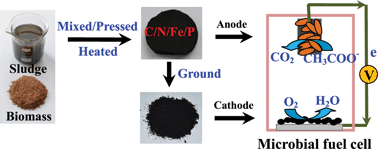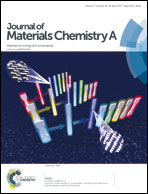Conversion of sewage sludge into high-performance bifunctional electrode materials for microbial energy harvesting†
Abstract
Conversion of sewage sludge (SS) into value-added biochar has garnered increasing attention due to its potential applications as a soil amendment and pollutant adsorbent. In this study, we propose a new application of the SS-derived biochar as an advanced bifunctional electrode material (anode and cathode) in microbial fuel cells (MFCs). To function as an anode, the SS amended with various amounts of coconut shell was pressed into a mold and then converted into SS-derived carbon monoliths (SMs) by heat treatment. Meanwhile, powdered SMs (PSMs) were used as the catalysts for oxygen reduction in the cathodes of the MFCs. The maximum power density of 969 ± 28 mW m−2 was achieved from the MFC with a SM anode and a PSM cathode, which was ca. 2.4 times that of the MFC with a graphite anode and a Pt cathode. The enhanced electrical conductivity of the SMs caused by amending the coconut shell resulted in the enrichment of exoelectrogens and the decrease in electron transfer resistance, which were responsible for the excellent performances of the as-prepared electrodes. This study suggests a promising method to convert SS into bifunctional electrode materials, offering a new opportunity for value-added applications of SS-derived biochar.


 Please wait while we load your content...
Please wait while we load your content...